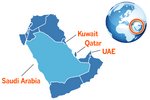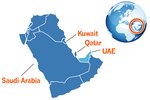Glossary of Terms for Those Thinking About Working in Saudi Arabia
By: Cindy Piccolo
 See our glossary sections below:Work-RelatedAuthentication: You will hear this term in reference to the visa process. To obtain your work visa for Saudi Arabia, you need to have your degree (and/or possibly other documents) "authenticated." An authentication is done by a government official who certifies the signature, seal, and/or position of the person who notarized the document. (See Notarization below.) This is done prior to individuals leaving for Saudi Arabia. Expatriate or Expat: This is a person who is working or voluntarily living outside of their country of citizenship. (If non-voluntarily, the person would be an exile or refugee.) Hejira Calendar (aka Islamic Calendar): This is the calendar that is followed in Saudi Arabia for religious purposes. However, the Gregorian calendar that Westerners use is used for business and general usage. The Hejira calendar is a lunar calendar with 12 months, each of 29 or 30 days, making the Hejira year 11 days shorter than the Gregorian year. For a fuller explanation, see our article The Heijira, or Islamic Calendar. Igama (also written as iqama): This is your Saudi residency visa (also known as your residency permit or work permit). It is not the same as the employment visa that was stamped in your passport and allowed you to enter the country. The hospital applies for your igama once you are onsite; normally, it takes one to two months to process. Islamic Calendar: See Heijira Calendar LONO: Pronounced "low-no." The acronym stands for Letter of No Objection (also known as Letter of Release, or NOC - No Objection Certificate). A LONO states that you completed your contract and complied with the laws of Saudi Arabia. Some employers and embassies no longer require a LONO, but some still require it if you have worked in Saudi Arabia within the past two to five years. Without a LONO, an employer may refuse to hire you and the Saudi Embassy may refuse to grant you an employment visa. Maasalama Party: Maasalama means good-bye in Arabic. The term usually refers to the departure party for a colleague who is returning to their home country. NOC: No Objection Certificate; the same as LONO. Notarization: You will hear this term in reference to the visa process. In the case of the visa process, notarization confirms that a photocopy of an original document (e.g., one's degree) is a true copy of the original. The notarized document will be submitted to the Saudi Embassy as part of your employment visa documents. Notarization is done by a notary public (who may also be a lawyer). Riyal or Rial: You are paid in Saudi riyals, the unit of currency in Saudi Arabia. You often see Saudi riyals noted as "SR." Since 1984, the Saudi riyal has been pegged to the US dollar at a rate of US$1=SR3.75. One Saudi riyal has 100 halalas. There are notes in the denominations of 1, 5, 10, 20, 50, 100, and 500 riyals, and coins in 5, 10, 25, 50, and 100 halalas. Visa: A visa is a stamp, sticker, or scan placed by officials of a foreign country in your passport that allows you legally to enter that country. There are different kinds of visas for different purposes. In Saudi Arabia, there are employment visas, visit visas, business visas, and hajj and umrah visas (i.e., religious pilgrimage visas). Most healthcare professionals enter the country on an employer-sponsored employment visa. In some cases, e.g., physician locums, the doctor may enter the country on an employer-sponsored visit visa. Unlike most countries, Saudi Arabia also requires people to have a visa to exit the country. So, for example, if someone is working in the Kingdom, and is going on vacation, then coming back, the person gets an exit/reentry visa. If someone has completed their contract and is going home for good, then that person gets an exit-only visa. Most exit/reentry visas are one-time visas, but you may choose to obtain a "multiple exit/reentry visa." Clothing:Abaya: This is the (usually) black garment that many women wear over their clothes while in public places. Styles and fabrics vary. Some are like long caftans, some are more cloak-like; some are entirely plain, some have embroidery or applique accents. Fabrics include crepes, chiffons, silks, etc. The abaya covers the body, but not the head, hands, or feet. Also see: The Top 7 Great Things About Abayas! and our video about abaya shopping in Riyadh. Abayas are no longer mandatory attire for women. Bisht: A loose outer cloak worn over the thobe by men. The garment is usually made of wool and is a darker material - brown, black, etc. Also see shemagh, ghutra, keffiyeh, igal, and thobe. Boshiya (also known as a ghatwa): A full black veil that completely covers a woman's face. Also see: niqab. Ghatwa (also known as a boshiya): A full black veil that completely covers a woman's face. Also see: niqab. Ghutra: A head covering for males. Strictly speaking, it refers to a covering made of white material; however, the term is also often used (particularly by Westerners working in the Kingdom) for the red and white, black and white, etc., checker-like patterned coverings, which are properly the keffiyeh and shemagh (see below). Also see tagiyah, igal, thobe, and bisht. Hijab: The word literally means cover, curtain, or veil, but has different uses. It can generally refer to modest dress and head covering among women, or it can refer specifically to the head covering of women. Tagiyah: A white knitted skull cap worn under the ghutra. Also see: thobe, bisht, shemagh, ghutra, and keffiyeh. Igal: A rope-like cord, often black, which is used to help keep a man's head covering (ghutra, keffiyeh, or shemagh) in place. Also see: thobe, bisht, shemagh, ghutra, tagiyah, and keffiyeh. Keffiyeh (also written as kafiyah, kaffiyeh, etc.): The head covering for males, usually in black and white, or red and white; former Palestinian leader, Yasser Arafat, wore a black and white checkered Keffiyeh. The term is also often used interchangeably with ghutra and shemagh. Also see igal, thobe, and bisht. Niqab: A face veil which comes in a full or half style. The full style consists of two bands which fully cover the face, but leave a narrow opening for the eyes. The half style usually leaves not only one's eyes, but part of one's forehead visible. Shemagh (also written other ways, e.g., shmagh, shamagh): A head covering for males. It often refers to a covering made of white material with red embroidery; however, the term is often used interchangeably with keffiyeh and ghutra. Also see igal, thobe, and bisht. Thobe: The long, full-length robe, usually made of lightweight white material, worn by men. During cooler months, the robe may be a heavier and darker material (grey, navy, or black). Also see: bisht, igal, shemagh, ghutra, and keffiyeh. Food and BeveragesBaba Ghanoush: A dip or spread whose main ingredients are eggplant, olive oil, garlic, and tahini (see "Tahinii" below). (For a recipe, see: Middle Eastern Cuisine and Recipes.) Hummus: A dip whose main ingredients include chickpeas, olive oil, lemon juice, garlic, and tahini (see "Tahini" below). (For a recipe, see: Middle Eastern Cuisine and Recipes.) Saudi Champagne: Alcohol is forbidden in Saudi Arabia; however, a tasty, refreshing, non-alcoholic substitute is made with sparkling water (e.g., Perrier, San Pellegrino), sparkling apple juice, mint, and sliced fruit (e.g., apple, lemon, orange). Shawarma: A (very tasty) fast-food sandwich usually made with pita bread, shaved meat (e.g., chicken, lamb, goat, beef), vegetables (e.g., lettuce, cucumber, tomatoes, onion), and a sauce or dressing (e.g., hummus, garlic sauce, tahini). (Recently, I sat next to an Egyptian man on a plane who insisted that Syrians make the best shawarma.) Tabbouli (also written as Tabbouleh): A salad whose main ingredients include chopped parsley, bulgur, and tomatoes. (For a recipe, see: Middle Eastern Cuisine and Recipes.) Tahini: A paste made of ground sesame seeds and used in Middle Eastern cooking. People, Culture, and ReligionBedouin: The name for the (formerly) nomadic, pastoral desert people of several countries of the Middle East and North African deserts. In Saudi Arabia, most Bedouins have settled into towns or cities. Eid: The word means feast, and is particularly familiar for the two Muslim holidays: Eid Al Fitr, which follows Ramadan, and Eid Al Adha, which follows the Hajj pilgrimage. Haraam: An Arabic term meaning anything forbidden in accordance with Islamic law. It can refer to forbidden behavior, food, and objects. It is the opposite of halal. Halal: An Arabic term meaning something permissible in accordance with Islamic law. It can refer to acceptable behavior, food, and objects. However, when this term is seen in Western countries, it is most commonly used only to refer to foods acceptable within Muslim dietary laws. It is the opposite of haraam. Mutawa (plural: Mutaween): A name used for the religious police in Saudi Arabia. The organization's formal name is often translated as the "Committee for the Promotion of Virtue and the Prevention of Vice." Unlike the regular police who, as elsewhere, handle issues such as traffic violations, property crime, etc., the mutaween enforce religious law (e.g., dress codes, prayer times, separation of sexes). The mutaween often patrol with the regular police. Quran (also written as Qur'an, Koran): The holy book of Islam. Religious Police: See Mutawa. Shariah Law (aka Islamic law or Muslim law): This is the wide body of Islamic religious law, dealing with all aspects of daily life. It is not just a system of criminal justice; it is a code of living. For a brief overview, see our article Shariah Law. Souk (also written as Souq, Sooq): A traditional market. The markets may be specialized, e.g., a gold souk, a vegetable souk, etc. Geography/TopographyEmpty Quarter: This is the English for the Arabic Rub' al Khali. The Empty Quarter is one of the largest sand deserts in the world, and covers about 650,000 square kilometers (250,000 square miles) of the Arabian Peninsula, including southern Saudi Arabia, and parts of the UAE, Oman, and Yemen. Oasis: An isolated, fertile place in a desert, where there is a spring that breaks ground or underground water source (e.g., river, aquifer) that is close to the surface. An example of a large oasis in Saudi Arabia is the Al-Ahsa (also known as Al-Hasa) oasis in the Eastern province. Wadi: A valley or dry riverbed (which may flood during rain storms). Most Popular |
Related |
Copyright (C) 2025 Helen Ziegler and Associates. All rights reserved.









